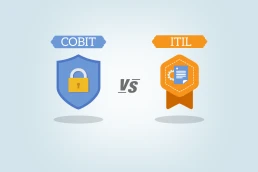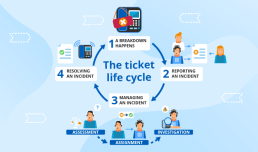COBIT vs ITIL: A Real-Life Example of What These Two Can Do.
COBIT vs ITIL: A Real-Life Example of What These Two Can Do.
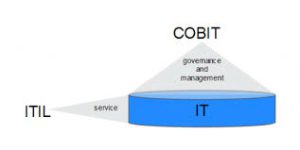

Contemplating the implementation of IT Service Management (ITSM) and feeling uncertain about the suitable framework? In this exploration, we aim to assist you by drawing a real-life comparison between ITIL and COBIT within an enterprise context. Before delving into practical assessments, let's take a moment to understand the theoretical distinctions between COBIT and ITIL.
Unveiling the Dynamics: ITIL vs COBIT - Navigating the Differences
Introduction: Embarking on the journey of optimizing IT Service Management (ITSM) often leads organizations to a crucial crossroads: choosing the right framework. In the realm of IT governance, two prominent contenders, ITIL (Information Technology Infrastructure Library) and COBIT (Control Objectives for Information and Related Technologies), stand out. This blog post dives into the intricacies of ITIL vs COBIT, shedding light on the distinctions that can guide organizations towards informed decision-making.
Understanding the Foundations: Before delving into the divergences, let's establish a foundational understanding of ITIL and COBIT.
ITIL: ITIL, a comprehensive framework, is renowned for its service-centric approach. It delineates a set of best practices for IT service management, focusing on delivering value to customers through quality service delivery and continual improvement.
COBIT: On the other hand, COBIT is a framework developed by ISACA, concentrating on IT governance and control. COBIT provides a structured approach to aligning IT goals with overall business objectives, emphasizing risk management, regulatory compliance, and efficient control mechanisms.


Exploring the Differences:
-
Focus and Scope:
- ITIL: Primarily concentrates on the end-to-end service lifecycle, emphasizing service strategy, design, transition, operation, and continual service improvement.
- COBIT: Puts a strong emphasis on governance and control, aiming to ensure that IT processes align with business goals, mitigate risks, and comply with regulatory requirements.
- Process vs. Control:
- ITIL: Centers around defining and refining processes to enhance service delivery, with a focus on efficiency and customer satisfaction.
- COBIT: Prioritizes control objectives and IT governance, emphasizing the establishment of policies, procedures, and monitoring mechanisms.
- Flexibility vs. Rigidity:
- ITIL: Offers flexibility in implementation, allowing organizations to adopt and adapt practices based on their specific needs and contexts.
- COBIT: Provides a more structured and prescriptive approach, ensuring a standardized set of controls for governance and compliance.
Conclusion: In the dynamic landscape of ITSM, choosing between ITIL and COBIT is a pivotal decision. Organizations must carefully weigh their priorities, considering factors such as service delivery, governance, compliance, and risk management. Ultimately, the choice between ITIL and COBIT depends on the unique requirements and goals of each organization. By understanding the nuances of these frameworks, businesses can navigate the ITSM landscape with clarity and confidence.
Under Observation of T4e Automation:
At T4e Automation, the deliberation between COBIT and ITIL unfolds as a strategic exploration tailored to the unique dynamics of the company. In this observant journey, COBIT, with its meticulous emphasis on governance, control, and risk management, emerges as a beacon for navigating the intricate landscape of T4e Automation's IT infrastructure. The structured framework of COBIT aligns seamlessly with the company's commitment to precision, offering a comprehensive solution to streamline IT processes, ensure regulatory compliance, and fortify risk resilience. Conversely, ITIL, recognized for its service-centric ethos, beckons with promises of optimizing the end-to-end service lifecycle.
The adaptability of ITIL becomes a key consideration for T4e Automation, allowing the company to tailor best practices to its specific needs, fostering service efficiency, and elevating customer satisfaction. As T4e Automation contemplates this crucial decision, the choice between COBIT and ITIL unfolds not merely as a selection between frameworks but as a strategic alignment with the company's vision, operational nuances, and commitment to delivering cutting-edge automation solutions.
Here are some of the problems that the company is facing and their COBIT-provided solutions:
The Landscape of Corporate Challenges:
Complex IT Environments:
- Challenge: The rapid evolution of technology often results in complex IT landscapes, making it challenging for companies to maintain operational efficiency and security.
- Solution with COBIT: COBIT provides a structured framework for IT governance, helping organizations streamline and optimize their IT processes. By aligning IT goals with business objectives, COBIT facilitates a cohesive and efficient IT environment.
Regulatory Compliance:
- Challenge: Navigating the ever-expanding landscape of regulations. Poses a significant challenge for companies aiming to ensure compliance and avoid legal repercussions.
- Solution with COBIT: COBIT incorporates a robust control framework, aiding organizations in establishing and maintaining compliance with regulatory requirements. It provides a systematic approach to implementing controls and monitoring processes to meet legal standards.
Risk Management:
- Challenge: Identifying and mitigating risks in an ever-changing business environment is a constant struggle for companies seeking to protect their assets and reputation.
- Solution with COBIT: COBIT places a strong emphasis on risk management, offering a comprehensive set of controls and guidelines. By integrating risk management practices into IT processes, COBIT assists companies in proactively identifying and addressing potential risks.
Aligning IT with Business Goals:
- Challenge: Ensuring that IT initiatives align seamlessly with overarching business objectives can be a daunting task for organizations aiming for strategic cohesion.
- Solution with COBIT: COBIT acts as a bridge between IT and business, providing a framework that aligns IT goals with the strategic objectives of the organization. This alignment enhances the contribution of IT to overall business success.
Here’s how ITIL can solve the problems that IT teams in MN Logistics face and cause;
In the fast-paced realm of logistics, where precision and efficiency are paramount, the role of Information Technology (IT) is indispensable. MN Logistics, like many industry players, faces its share of IT challenges that can impede operations and hinder growth. In this blog post, we'll explore how the implementation of ITIL (Information Technology Infrastructure Library) can be the game-changer MN Logistics needs to overcome its IT hurdles and usher in a new era of streamlined logistics excellence.
Identifying MN Logistics' IT Pain Points:
- Service Downtime and Disruptions: MN Logistics grapples with the recurring issue of service downtime and disruptions, impacting the seamless flow of operations. These interruptions not only lead to productivity losses but. Also tarnish the reputation of the company in the eyes of clients and partners.
- Lack of Standardized Processes: The absence of standardized IT processes within MN Logistics creates a scenario where tasks are handled inconsistently. This lack of uniformity not only hampers efficiency but also introduces the risk of errors and miscommunication.
- Inadequate Change Management: Keeping pace with the evolving logistics landscape requires MN Logistics to adapt swiftly to technological changes. However, the absence of a robust change management system often leads to resistance, confusion, and disruptions when implementing new IT initiatives.
How ITIL Can be the Solution:
- Service Lifecycle Approach: ITIL's service lifecycle approach aligns seamlessly with the logistical needs of MN Logistics. By implementing ITIL practices, MN Logistics can ensure a holistic and well-coordinated approach to service management, from strategy and design to transition, operation, and continual improvement.
- Standardization for Efficiency: ITIL emphasizes the importance of standardizing processes to enhance efficiency. MN Logistics can benefit from adopting ITIL's best practices. Creating a consistent framework that optimizes resource utilization, reduces errors, and ensures a smoother workflow.
- Change Management Excellence: Addressing MN Logistics' challenge in embracing technological change, ITIL provides a structured change management process. This ensures that changes are well-planned, communicated effectively, and implemented with minimal disruption. Fostering a culture of adaptability within the organization.
Conclusion:
In the dynamic landscape of IT Service Management (ITSM). Where the convergence of technology and business objectives is paramount, the choice between COBIT and ITIL becomes a strategic cornerstone for organizational success. This exploration has illuminated the theoretical distinctions. Practical applications of these two formidable frameworks, offering a roadmap for businesses navigating the complexities of IT governance.
As organizations contemplate the implementation of ITSM. The COBIT vs. ITIL dilemma is not a binary choice but a nuanced decision-making process. The stark differences in focus, approach. And flexibility between ITIL's service-centric model and COBIT's governance and control emphasis provide organizations. With diverse tools to address their unique challenges.
On the other hand, the journey into the logistics realm with ITIL unveils its transformative potential for entities like MN Logistics. The service lifecycle approach proves instrumental in addressing specific pain points such as service downtime. Lack of standardized processes, and the need for change management excellence. ITIL's emphasis on standardization and adaptability aligns seamlessly with the intricate demands of the logistics industry.
As businesses traverse the complex terrain of ITSM, armed with the insights from this comparison. They are better equipped to make informed decisions. By understanding the nuances of COBIT and ITIL, organizations can embark on a journey that transcends mere IT optimization. Fostering a culture of adaptability, efficiency. And strategic alignment with overarching business goals.
ServiceNow: Realizing the Power of Modern Service Management
Understanding ServiceNow and Its Versatility Across Departments:


The ServiceNow ticketing system is not just for IT; it's a powerful tool that caters to the diverse needs of mid-size and large organizations. Primarily recognized for its excellence in IT Service Management (ITSM), ServiceNow has expanded its influence into various other domains. Our experience in ServiceNow consulting reveals its applicability across departments such as:
- Sales, Marketing, and Customer Service
- Human Resources
- Accounting
- Finance
- Legal
- Research and Development
- Procurement
- Production
- Logistics
While each department may leverage ServiceNow to different extents, its capabilities go beyond ticketing. From reporting, audits, and risk management to self-service portals, chatbots, and surveys, ServiceNow offers a comprehensive suite of functionalities. If you're new to optimizing processes with ServiceNow, starting with IT ticketing is a wise initiation.
Who Can Harness the Power of ServiceNow?


Given its robust functionality and intricate process hierarchy, ServiceNow is best suited for mid-sized and large organizations. The ServiceNow value calculator indicates that organizations with a minimum of 500 employees stand to gain significant benefits. Smaller companies might find their internal processes too straightforward for the complexity that ServiceNow offers.
Industries that can benefit from ServiceNow span a wide spectrum:
- Financial services and accounting
- IT product companies
- Insurance
- Healthcare and pharmaceuticals
- Banking
- Public services
- Retail
- Marketing and advertising
- Manufacturing
- Oil and energy
- Legal services
- Hotels and accommodation
- Non-profit organizations
- Aviation and aerospace
- Transportation
- Real estate, etc.
Achieving Tangible Results with ServiceNow
As a ticketing tool, ServiceNow yields numerous benefits, including:
Financially Rewarding Results
- Reduced Downtimes and Operational Costs: Accelerating ticket resolution with ServiceNow translates to substantial annual savings, as exemplified by a potential $208,000 saving for a company with 2,000 employees and 10,000 yearly tickets.
- IT Cost Reduction: Increased productivity and automation of repetitive tasks can lead to significant IT cost savings, estimated at $450,000 per year for a 2,000-employee company.
Bonus Results
- Increased User Satisfaction: Faster ticket resolution times contribute to higher user satisfaction, fostering a positive change in the IT support culture.
- Enhanced Visibility Across IT Operations: ServiceNow serves as a solid backbone for IT processes, offering clear visibility into the process hierarchy and facilitating the onboarding of new IT personnel.
- Monitoring and Managing IT Department Performance: Intuitive reporting functionality enables the measurement and improvement of IT department performance, benefiting both operational teams and higher administrative levels.
Technical ABCs of ServiceNow Ticketing
As the leading ITSM platform endorsed by Gartner, let's delve into the technical specifics of ticketing using IT examples.
The Ticket Life Cycle
In the realm of ServiceNow, the basic equivalent of a ticket is an incident. Examining the life cycle of a sample incident—let's say, a broken office phone—illustrates the technical intricacies within ServiceNow.
Reporting an Incident
Employees from various roles can report incidents through different channels:
- IT staff can create incidents directly in ServiceNow.
- Users can report incidents via email, phone calls, or the company's Service Portal.
- Third-party suppliers or partners may also report incidents if agreed upon.
ServiceNow can also automate incident creation through regular analysis of system logs, triggering incident creation upon identifying malfunctions.
Managing an Incident
ServiceNow handles incidents through a series of steps:
- Assessment: Analyzing the impact and urgency of an incident to prioritize and initiate the resolution countdown.
- Assignment: Automatically assigning incidents based on description to relevant IT specialists, or manual assignment for more complex tasks.
- Investigation: The assigned specialist analyzes the incident to restore normal business processes.
Users experiencing the incident can monitor the resolution process, with ServiceNow providing notifications and the option to cancel the incident if the issue resolves without IT assistance.
Resolving an Incident
ServiceNow ensures that resolving an incident involves specifying the type of resolution, the resolver, and the resolution date. If the incident is resolved, the associated user needs to close it; otherwise, escalation rules come into play to ensure timely resolution.
The Types of Tickets and Why We Need Them
ServiceNow differentiates between incident, problem, request, and change tickets to enhance efficiency:
- Incident: Unplanned events causing interruptions to IT services.
- Problem: Severe malfunctions or root causes behind multiple incidents.
- Request: User requests for IT support or other departmental assistance.
- Change: Proposals to add, modify, or remove elements concerning IT services.
Understanding these ticket types is crucial for efficient IT operations, preventing the recurrence of similar incidents and optimizing overall service efficiency.
ServiceNow’s Soft Spots
While Service Now is a powerhouse for organizational optimization, it's essential to consider its limitations:
- Price Consideration: Service Now licenses are not budget-friendly, and additional costs for implementation and support should be anticipated.
- Reporting Challenges: While suitable for low-level operational needs, high-level performance dynamics analysis may require external tools or the purchase of ServiceNow's Performance Analytics app.
- Customization Maintenance: Heavily customized solutions may pose challenges in maintaining compatibility with future Service Now releases, necessitating ongoing customization maintenance.
Possible Alternatives
For organizations exploring alternatives, several options cater to varying needs:
- Spiceworks: Suitable for small to mid-sized organizations with straightforward IT processes.
- Jira Service Desk: Customizable but may have reported defects and missing features.
- Zendesk: Offers solid ITSM functionality but lacks SLA features.
- BMC Helix Remedy: Highly customizable but comes with a higher price tag and reported UI challenges.
Choice Complete?
The decision to adopt ServiceNow hinges on several factors:
- Company Size
- Process Complexity
- Preferred Ticketing Process
- Budget
- Future Optimization Plans
If these align with ServiceNow's characteristics, the platform promises substantial savings and process optimization, making it a worthy investment for your organization's IT or other departmental needs.
Optimization Strategies: Elevating Your ServiceNow Platform to Peak Efficiency
4 Levels of Effective ServiceNow® Platform Implementation
Embarking on the journey of ServiceNow® platform implementation requires a strategic approach that aligns seamlessly with organizational goals and processes. In this blog post, we delve into the intricacies of this transformative journey, uncovering the four distinct levels that characterize an effective Effective Service implementation. From the foundational level, where the groundwork is laid for future innovations, to the advanced stages that leverage the platform's full potential, we navigate through each phase, unravelling key insights and best practices. Whether you're a seasoned IT professional seeking to optimize workflows or a business leader aiming for enhanced efficiency, this exploration of the 4 Levels of Effective ServiceNow® Platform Implementation serves as your comprehensive guide to unlocking the platform's capabilities and driving sustainable success within your organization. Join us as we navigate through the layers of implementation excellence, providing actionable insights that propel your ServiceNow® journey to new heights.
A quick model overview
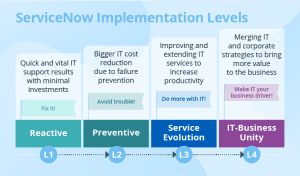

Unlock the full potential of the ServiceNow® platform with our strategic approach to implementation, structured across four distinct levels. At Level 1, we initiate a comprehensive analysis of your business processes, ensuring a solid foundation for customization. Moving to Level 2, we focus on core system configuration, leveraging out-of-the-box functionalities to align the platform with your specific requirements. Level 3 marks the integration phase, seamlessly connecting ServiceNow® with your existing IT infrastructure and other enterprise tools, fostering a unified and efficient ecosystem. Finally, at Level 4, we emphasize continuous improvement and innovation, promoting ongoing optimization, proactive maintenance, and the exploration of advanced features to keep your ServiceNow® implementation at the forefront of technological excellence. Our four-tiered approach ensures a holistic and scalable implementation, empowering your organization to harness the full capabilities of the ServiceNow® platform for enhanced productivity and service delivery.
At Level 1: Reactive
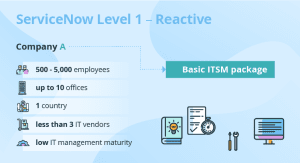

Implementing the ServiceNow® platform with a focus on reactive levels of effectiveness is a strategic approach that can significantly enhance operational efficiency and user satisfaction. Here's a breakdown of the key elements that contribute to the reactive levels of effective ServiceNow® platform implementation:
- Incident Response Excellence: Reactive efficiency begins with a robust incident response mechanism. A well-implemented ServiceNow® platform allows organizations to swiftly identify and respond to incidents, minimizing downtime and ensuring that issues are addressed promptly. This not only improves service quality but also enhances the overall user experience.
- Real-time Monitoring and Alerts: One of the pillars of effective reactivity is the ability to monitor systems and receive real-time alerts. The ServiceNow® platform provides advanced monitoring capabilities, allowing organizations to proactively identify potential issues before they escalate. This real-time awareness enables quick decision-making and reduces the impact of disruptions.
- Automated Workflow Remediation: Implementing automated workflows on the ServiceNow® platform ensures that routine tasks and incident responses are handled promptly. This not only accelerates the resolution process but also minimizes the risk of human error. By automating repetitive tasks, organizations can focus on strategic initiatives rather than spending excessive time on manual interventions.
- User-Centric Service Desk: A reactive ServiceNow® implementation revolves around a service desk that is not just incident-centric but user-centric. The platform's capabilities allow organizations to create a seamless and personalized experience for end-users. This includes self-service options, user-friendly interfaces, and quick query resolutions, contributing to heightened satisfaction levels.
- Continuous Improvement with Analytics: Leveraging the analytics and reporting features of the ServiceNow® platform is crucial for reactive effectiveness. Organizations can analyze incident trends, identify recurring issues, and implement preventive measures. This data-driven approach ensures continuous improvement in service delivery and positions the organization to respond proactively to emerging challenges.
- Adaptability to Change: Reactivity in the ServiceNow® context is not just about responding to incidents but also adapting to changing business requirements. A well-implemented platform should be flexible and scalable, allowing organizations to modify workflows, introduce new services, and integrate seamlessly with evolving technologies, ensuring long-term effectiveness.
- User Training and Adoption Programs: To maximize the reactive levels of the ServiceNow® platform, organizations should invest in comprehensive user training and adoption programs. Ensuring that all stakeholders are proficient in utilizing the platform's features empowers them to make the most of its capabilities, leading to faster issue resolution and increased operational agility.
In conclusion, adopting a reactive approach to ServiceNow® platform implementation is a strategic move towards a more agile and responsive IT service management environment. By focusing on incident response, real-time monitoring, automation, user-centric service delivery, analytics, adaptability, and user proficiency, organizations can unlock the full potential of the ServiceNow® platform in enhancing overall operational efficiency and service quality.
Preventive Levels of Effective ServiceNow® Platform Implementation:
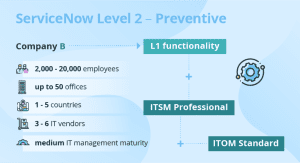

Implementing the ServiceNow® platform is a transformative step for organizations seeking to optimize their workflows and enhance overall efficiency. To ensure a seamless integration and ongoing success, a proactive approach at various levels of implementation is crucial. Here are the preventive measures that contribute to the effectiveness of ServiceNow® platform implementation:
Comprehensive Needs Assessment:
- Before embarking on the implementation journey, conduct a thorough assessment of your organization's unique needs and challenges. Understanding the specific requirements allows for a tailored configuration of the ServiceNow® platform, minimizing the risk of overlooking critical functionalities.
Stakeholder Involvement and Communication:
- Effective communication and involving stakeholders from various departments are vital components of successful implementation. Keeping all relevant parties informed and engaged helps in preventing misunderstandings, resistance to change, and ensures that the platform aligns with the diverse needs of the organization.
Robust Training Programs:
- Prevention begins with education. Investing in comprehensive training programs for users at all levels is essential. This proactive measure ensures that employees are well-equipped to navigate the ServiceNow® platform, reducing the likelihood of errors, and maximizing the platform's potential for productivity gains.
Continuous Testing Protocols:
- Implementing a robust testing strategy is a preventive measure that catches potential issues before they become critical. Regularly test configurations, workflows, and integrations to identify and address any discrepancies, ensuring a stable and reliable ServiceNow® environment.
Security Best Practices:
- Security is paramount in any digital transformation. Implementing preventive security measures, such as adherence to industry best practices, regular security audits, and user access controls, safeguards sensitive data and protects the organization from potential cyber threats.
Scalability Planning:
- Anticipating future growth and changes in organizational dynamics is key to preventive implementation. Design the ServiceNow® platform with scalability in mind, ensuring it can accommodate increased data loads, users, and additional functionalities without compromising performance.
Regular Platform Updates and Maintenance:
- ServiceNow® regularly releases updates and enhancements to improve functionality and security. Staying proactive in applying these updates and conducting routine maintenance ensures that the platform operates at peak efficiency, and organizations benefit from the latest features and security patches.
Feedback Mechanisms:
- Establishing feedback mechanisms allows users to report issues and suggest improvements. Proactively addressing feedback contributes to continuous improvement and user satisfaction, creating an environment where the ServiceNow® platform evolves in tandem with the organization's changing needs.
In conclusion, the preventive levels of effective ServiceNow® platform implementation involve a strategic, proactive, and comprehensive approach. By addressing potential challenges before they escalate, organizations can maximize the benefits of the ServiceNow® platform, fostering a culture of efficiency, collaboration, and innovation.
Preventive Service Evolution: Level of Effective ServiceNow® Platform Implementation:
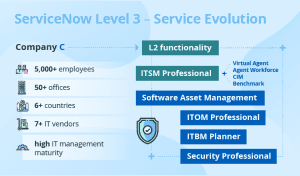

In the rapidly evolving landscape of service management, the implementation of the Effective Service platform has become synonymous with a proactive and preventive approach to service delivery. This transformative technology doesn't just manage incidents but reshapes the entire service ecosystem. Let's delve into the different levels of effective implementation that mark the evolution of preventive services through the ServiceNow® platform.
- Foundation Level: Laying the Groundwork for Prevention
At the foundation level, organizations initiate their Effective Service journey by establishing a robust framework for incident management. This involves setting up a centralized system for logging and tracking issues, creating a baseline for service awareness. This foundational step is crucial, as it forms the backbone for more advanced preventive measures.
- Automation Proficiency: Streamlining Operations for Proactive Intervention
As organizations move to the next level, they leverage the power of automation within the ServiceNow® platform. This entails the automation of routine tasks, enabling the system to detect and resolve issues before they impact users. Automated incident response, intelligent routing, and self-healing capabilities become key components, contributing to a more proactive and efficient service model.
-
Predictive Analytics Integration: Anticipating Issues Before They Occur
The evolution continues with the integration of predictive analytics. By harnessing the data collected within the ServiceNow® platform, organizations can predict potential service disruptions before they manifest. Machine learning algorithms analyze historical data patterns, allowing for the identification of trends and potential areas of concern. This level of foresight empowers service teams to address issues at their root, preventing future incidents.
- Continuous Improvement and Learning: Adapting in Real Time
The most advanced stage of preventive service evolution involves continuous learning and improvement. Organizations at this level use the Effective Service platform not just as a static tool but as a dynamic learning system. Machine learning algorithms continuously adapt and refine based on real-time data, ensuring that the preventive measures stay ahead of evolving challenges. This adaptive approach enables organizations to stay resilient in the face of changing service landscapes.
Conclusion: Shaping the Future of Service Management
The evolution of preventive services through the Effective Service platform is a journey that transforms organizations from reactive problem solvers to proactive service innovators. By embracing automation, predictive analytics, and continuous learning, businesses can not only prevent disruptions but also shape the future of service management, creating a resilient and agile service ecosystem. As technology advances, the ServiceNow® platform stands as a beacon for organizations seeking to stay ahead in the dynamic and demanding world of service delivery.
Level 4 – IT-Business Unity:
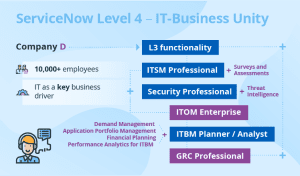

In the dynamic landscape of contemporary business operations. The symbiotic relationship between Information Technology (IT) and business units has undergone a transformative evolution. A pivotal player in this paradigm shift is the implementation of the Effective Service platform. A versatile solution designed to streamline processes, enhance collaboration, and elevate overall efficiency. As organizations embark on this journey of IT-business unity through ServiceNow®, distinct evolutionary levels emerge, each marking a milestone in the pursuit of effective digital transformation.
- Foundation Establishment:
The initial stage in the IT-Business Unity Evolution involves laying the foundation for Effective Service implementation. This phase encompasses comprehensive planning, stakeholder engagement, and an in-depth analysis of organizational needs. Establishing a robust foundation ensures that the subsequent stages are built on a solid framework. Aligning the ServiceNow® platform with the unique objectives and challenges of the business.
-
Seamless Integration:
The evolution progresses with the seamless integration of the Effective Service platform into existing IT infrastructure and business processes. This level focuses on interoperability, ensuring that the platform acts as a cohesive force. Connecting disparate systems and fostering a unified digital ecosystem. Successful integration facilitates real-time data sharing, reducing silos and enhancing cross-functional collaboration.
- Process Optimization and Automation:
As organizations mature in their ServiceNow® implementation, the focus shifts towards optimizing and automating critical business processes. This involves leveraging the platform's workflow capabilities to enhance efficiency, reduce manual intervention, and minimize the margin for error. By automating routine tasks, businesses can redirect resources towards strategic initiatives, fostering agility and innovation.
- Enhanced User Experience:
The evolution reaches a pivotal point with a heightened emphasis on user experience. Organizations recognize the significance of a user-friendly interface and seamless interaction with the Effective Service platform. Customization, intuitive design, and user-centric features become paramount. Ensuring that employees across the spectrum find value in the platform, thereby increasing overall adoption and maximizing its impact.
- Data-Driven Decision Making:
At the zenith of IT-business unity evolution, organizations leverage the rich data generated by the ServiceNow® platform for informed decision-making. Advanced analytics and reporting capabilities empower stakeholders to glean insights into operational performance. Identify areas for improvement, and make strategic decisions backed by data-driven intelligence. This level of sophistication transforms the ServiceNow® platform into a strategic asset that catalyzes innovation and continuous improvement.
In essence, the journey through the evolutionary levels of ServiceNow® platform implementation represents a commitment to fostering IT-business unity. It is a testament to the organization's adaptability, innovation, and strategic vision. Ultimately leading to a more agile, collaborative, and future-ready business ecosystem.
Proactive IT Audits for Robust Security and IT Audit Services and Why You May Need Them.
IT Audit Services and Why You May Need Them?
Welcome to our blog, where we delve into the dynamic realm of Information Technology and shed light on crucial aspects that can redefine the way your business operates. Today, let's explore a topic that often lurks in the shadows but is fundamental to the health and security of any organisation's IT infrastructure – "IT Audit Services and Why You May Need Them.


In the fast-paced digital landscape, where technology is the heartbeat of modern enterprises, the need for a comprehensive IT audit has never been more critical. Imagine your IT infrastructure as a complex puzzle, with each piece representing a component of your organization's operations. Now, an IT audit acts as the discerning eye that not only pieces together this intricate puzzle but also ensures each element functions optimally and securely.
- Comprehensive Security Assessment:
- Conduct thorough evaluations of your IT infrastructure to identify vulnerabilities, potential risks, and areas of improvement in cybersecurity measures.
- Assess the effectiveness of existing security protocols and recommend enhancements to safeguard sensitive data.
- Regulatory Compliance:
- Ensure that your IT systems align with industry-specific regulations and compliance standards.
- Conduct audits to verify adherence to data protection laws, privacy regulations, and other relevant compliance requirements.
- Risk Management:
- Identify and assess potential risks to your IT environment, including data breaches, system failures, and unauthorized access.
- Develop strategies to mitigate identified risks and enhance overall risk management protocols.
- Operational Efficiency:
- Evaluate the efficiency and effectiveness of IT processes and workflows.
- Identify opportunities for streamlining operations, reducing downtime, and optimizing resource utilization.
- Data Integrity and Accuracy:
- Verify the accuracy, completeness, and integrity of data stored within your IT systems.
- Implement measures to ensure data consistency, reliability, and the availability of accurate information for decision-making.
- Performance Evaluation:
- Assess the performance of your IT infrastructure, including hardware, software, and network components.
- Identify bottlenecks, system limitations, and opportunities for performance optimization.
- Cost Optimization:
- Review IT-related expenses and identify areas where costs can be optimized without compromising quality or security.
- Provide recommendations for cost-effective solutions and resource utilization.


Navigating the Digital Landscape: Unveiling the Stages of IT Auditing
In the ever-evolving realm of technology, businesses must stay ahead of the curve to ensure the integrity, security, and efficiency of their IT infrastructure. Enter IT auditing – a meticulous process designed to assess, enhance, and safeguard digital ecosystems. Let's unravel the stages of IT auditing, shedding light on the crucial journey every organization must undertake to fortify its digital foundations.
1. Pre-Audit Preparation: Laying the Groundwork for Success
Before the audit kicks off, meticulous preparation sets the stage for success. This phase involves defining the scope of the audit, understanding business objectives, and establishing clear communication channels. The auditors collaborate closely with key stakeholders, gaining insights into the intricacies of the organization's IT landscape. This preparatory stage is akin to charting a course before embarking on a transformative voyage.
2. Risk Assessment: Illuminating the Shadows
The second stage involves a deep dive into risk assessment. Here, auditors meticulously identify potential threats and vulnerabilities that could compromise the security and functionality of IT systems. This process not only gauges the susceptibility of the digital ecosystem to cyber threats but also informs strategic decisions on risk mitigation and management.
3. Audit Planning: Crafting the Roadmap to Excellence
Armed with insights from the risk assessment, auditors craft a detailed audit plan. This roadmap outlines the specific areas and processes to be scrutinized, the methodologies to be employed, and the timeline for the audit. An effective audit plan is akin to a well-crafted map, guiding auditors through the intricate terrain of It Audit Consultant systems with precision and purpose.
4. Fieldwork and Data Collection: Unveiling the Digital Tapestry
The heart of the audit lies in the fieldwork and data collection phase. Auditors delve into the nitty-gritty of IT operations, scrutinizing configurations, controls, and security measures. This stage is like unraveling the digital tapestry, exposing both the strengths and vulnerabilities woven into the intricate fabric of the organization's IT infrastructure.
5. Analysis and Evaluation: Decoding the Digital Language
Once data is collected, auditors shift into analysis mode. They evaluate the effectiveness of existing controls, assess compliance with industry standards, and gauge the overall health of the IT ecosystem. This stage involves deciphering the digital language – interpreting data patterns, anomalies, and trends to draw insightful conclusions.
6. Reporting and Recommendations: Crafting the Blueprint for Improvement
The penultimate stage involves compiling findings into a comprehensive report. Auditors articulate their discoveries, detailing strengths, weaknesses, and areas for improvement. This document serves as a blueprint for enhancing IT systems ,It Audit Consultant guiding organizations toward a more resilient and secure digital future.
7. Follow-Up and Continuous Improvement: Sustaining Digital Excellence
The final stage extends beyond the traditional audit timeline. Auditors collaborate with organizations to implement recommendations, monitor progress, and ensure sustained digital excellence. This iterative process fosters a culture of continuous improvement, adapting IT systems to the ever-evolving landscape of technology.
Embarking on the journey of IT auditing is not just a necessity but an opportunity for organizations to fortify their digital fortresses, ensuring they stand resilient in the face of technological challenges. As we navigate the stages of IT auditing, we pave the way for a future where digital landscapes are not just secure but thrive in their efficiency and innovation.
Unlocking Success: The Crucial Role of IT Auditing in Modern Businesses
In the rapidly evolving landscape of technology, where digital innovation is both a driving force and a potential risk, the significance of IT auditing cannot be overstated. It Audit Consultant serves as a powerful tool for businesses to ensure the integrity, security, and optimal performance of their digital infrastructure. In this blog post, we'll delve into the compelling reasons why your organization needs IT auditing.
- Security in the Digital Age: Protecting Your Assets
One of the primary motivations behind It Audit Consultant is the ever-present threat of cyberattacks. As businesses increasingly rely on digital platforms and store sensitive information online, the need for robust cybersecurity measures becomes paramount. IT auditing identifies vulnerabilities and provides strategic recommendations to fortify your defenses, safeguarding your data from malicious actors.
- Navigating the Regulatory Landscape: Ensuring Compliance
IT auditing acts as a compass, guiding your organization through the complex regulatory landscape. Whether it's GDPR, HIPAA, or other industry standards, an IT audit ensures that your systems align with these requirements, mitigating the risk of costly penalties and legal complications.
- Operational Excellence: Streamlining Your IT Processes
Efficiency is the heartbeat of any successful business. IT auditing goes beyond security concerns to assess the efficiency of your IT processes. By identifying bottlenecks, streamlining workflows, and optimizing resource allocation, IT audits contribute to enhanced operational excellence, reducing downtime and boosting overall productivity.
- Proactive Risk Management: Identifying and Mitigating Risks
Waiting for a security breach to occur is a risky strategy. IT auditing is a proactive measure that involves identifying potential risks before they escalate. By evaluating your risk landscape, IT audits empower your organization to implement preemptive strategies, minimizing the impact of potential disruptions and ensuring business continuity.
- Strategic Decision-Making: Aligning Technology with Business Goals
Your IT infrastructure should be a catalyst for achieving your business objectives. IT auditing evaluates the alignment between your technology investments and overall strategic goals. It Audit Consultant this insight enables informed decision-making, ensuring that your IT initiatives contribute directly to the success and growth of your organization.
- Building Stakeholder Trust: Demonstrating Accountability
Stakeholders, including clients, partners, and investors, entrust your organization with valuable data. Demonstrating a commitment to It Audit Consultant showcases your dedication to accountability and transparency. This, in turn, builds trust, enhancing your reputation and fostering stronger relationships with key stakeholders.
In conclusion, IT auditing is not merely a checkbox on a compliance list; it's a proactive and strategic investment in the longevity and success of your business. By addressing security concerns, ensuring compliance, optimizing operations, and aligning technology with business goals, IT auditing sets the stage for a resilient and thriving digital future. Embrace the power of IT auditing and unlock the full potential of your organization in the digital age.
Keep Your IT Environment in Check with T4e Automation
In the fast-paced digital landscape of today, where technology is the heartbeat of business operations, ensuring the health and security of your It Audit Consultant is paramount. Enter T4e Automation, your trusted partner in navigating the complexities of IT infrastructure. In this blog post, we explore why keeping your IT environment in check with the expertise of T4e Automation is a strategic move for businesses aiming to thrive in the digital era.


Why T4e Automation?
- Unparalleled Expertise:
At T4e Automation, we bring a wealth of expertise to the table. Our team comprises seasoned professionals with a deep understanding of diverse IT domains, from cybersecurity and compliance to network optimization and data management. Trust us to be the custodians of your digital assets.
- Comprehensive Security Assurance:
Cyber threats are ever-evolving, and T4e Automation is at the forefront of safeguarding your digital fortress. Our comprehensive IT audit services identify vulnerabilities, assess risks, and fortify your defenses. With us, you can rest assured that your sensitive data is shielded from potential threats.
-
Tailored Solutions for Your Business:
We understand that one size doesn't fit all. T4e Automation takes a personalized approach to It Audit Consultant solutions. Whether you're a small startup or an enterprise giant, our experts craft bespoke strategies that align with your unique business goals, ensuring optimal performance and efficiency.
- Proactive Risk Management:
Prevention is key. T4e Automation goes beyond mere issue resolution; we are proactive in identifying and mitigating risks before they become critical. Our robust risk management strategies keep your It Audit Consultant, minimizing the impact of potential disruptions.
- Compliance Confidence:
Navigating the regulatory landscape can be daunting. T4e Automation simplifies the compliance journey, ensuring that your IT systems adhere to industry-specific regulations. Stay ahead of the compliance curve with our thorough assessments and strategic guidance.
- Continuous Improvement Culture:
Technology is ever-evolving, and so are we. T4e Automation instills a culture of continuous improvement. Our commitment to staying abreast of the latest technological advancements ensures that your IT environment remains not just secure but also at the cutting edge of innovation.
- Responsive Support:
In the dynamic world of IT, issues can arise at any time. T4e Automation provides responsive support to address concerns promptly. Our team is on standby, ready to assist and resolve challenges, ensuring minimal disruption to your operations.
Conclusion: Elevate Your IT Confidence with T4e Automation
In the digital age, the resilience of your business hinges on the strength of your IT environment. Partner with T4e Automation to keep your systems in check, secure, and poised for success. Elevate your IT confidence with our expertise, and let's embark on a journey to transform your IT landscape into a strategic asset for your business growth.

